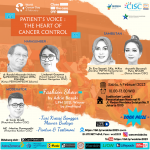LUNG CANCER
Lung cancer is the leading cause of death from malignancy in the world
About one third of all cancer deaths are in men. From various studies in various ward houses in Jakarta, cancer is the most cancer case in men and is the 4th largest in women. But it is a major cause of death.
Who is at risk for lung cancer?
Everyone has a risk for lung cancer. Caution must be increased in people who have risk factors. Risk will be reduced if control is carried out on risk factors as a preventive measure
Lung Cancer Risk Factors consist of:
1. Factors that can be controlled, namely:
- Exposed to cigarette smoke (both active and passive smokers)
- Live or work in mining areas or factories that contain cancer triggers (carcinogens)
- Live or work in areas with high pollution
- Exposure to pollution in the home, such as asbestos, kitchen smoke, excessive use of insect repellent
- Exposure to outdoor pollution, such as vehicle fumes, factory fumes, forest / land fire fumes
2. Faktor yang tidak dapat dikendalikan, yaitu:
- Age more than 40 years
- Family history of cancer
- Never had another cancer before.
Lung Cancer Diagnosis
For the diagnosis of lung cancer through several examinations, namely:
- Clinical examination by a doctor according to his competence
- Chest X-ray examination and chest CT scan with contrast
- Bronchoscope (bonchoscopy) examination
- Actions to obtain material / specimens for determination of cancer cell types, eg biopsy, etc.
Note: In some cases sometimes require other tests, such as brain CT scans, Bone scans, and so on
Lung Cancer Symptoms
Lung cancer symptoms can be seen or felt in the respiratory tract or other symptoms experienced by the body, namely:
- Respiratory / respiratory disorders, such as
- a long cough or a cough that doesn’t heal
- Coughing with blood
- Hard to breathe
- Arises chest pain
Other common symptoms are indicated by:
- Weight loss due to decreased appetite
- Hoarseness
- Great headache
- Convulsions
- Weakness of limbs especially legs
- Lumps in the neck, base of the neck and armpits
- Swelling on the face, neck and sometimes on the arms
Lung Cancer Detection
Until now there has been no screening method to detect lung cancer early. Therefore, an effort that can be done is the Control of Lung Cancer Risk Factors
- If you are in a risk group, then do a routine lung examination with a chest X-ray at least once a year. If possible every 6 months do a CT scan with contrast
- If you are in a high risk group (Risk Group with Symptoms)
- Lung Tuberculosis (TB): Evaluate after adequate pulmonary TB treatment for 2-4 weeks. If there is improvement, then continue the treatment of OAT drugs. If there is no improvement, ask to be referred for further examination to a lung specialist
- Not Lung Tuberculosis (TB), so ask for referral for further examination to a specialist lung doctor
Beware of Lung Cancer
- One of the efforts to prevent delays in diagnosis is to increase alertness in other lung disease sufferers with symptoms that resemble cancer, especially pulmonary tuberculosis (TB).
- Precautions need to be increased in patients with bacteriological negative pulmonary TB and patients included in the risk group for lung cancer.
- Perform an examination for a lung cancer diagnosis procedure if the evaluation of treatment results 2-4 weeks does not show a response.
Lung Cancer Treatment
Treatment of lung cancer is based on cancer cell types and disease staging and molecular changes (EGFR, ALK, PDL1)
Lung Cancer Treatment, consisting of:
- Surgery
- Radiotherapy
- Chemotherapy
- Target Therapy
- Immunotherapy
Source:
- Presentation paper on the Principles of Lung Cancer in the Training of Speakers event as a series of WORLD CANCER DAY 2019 organized by the KPKN, Ministry of Health RI, RSCM, FKUI
- Lung cancer brochure from the Republic of Indonesia Ministry of Health’s KPKN
http://kanker.kemkes.go.id/guidelines_read.php?id=4&cancer=7







Comments are closed.